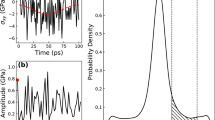Abstract
Revealing the microscopic structural and dynamic pictures of glasses is a long-standing challenge for scientists1,2. Extensive studies on the structure and relaxation dynamics of glasses have constructed the current classical picture3,4,5: glasses consist of some ‘soft zones’ of loosely bound atoms embedded in a tightly bound atomic matrix. Recent experiments have found an additional fast process in the relaxation spectra6,7,8,9, but the underlying physics of this process remains unclear. Here, combining extensive dynamic experiments and computer simulations, we reveal that this fast relaxation is associated with string-like diffusion of liquid-like atoms, which are inherited from the high-temperature liquids. Even at room temperature, some atoms in dense-packed metallic glasses can diffuse just as easily as they would in liquid states, with an experimentally determined viscosity as low as 107 Pa·s. This finding extends our current microscopic picture of glass solids and might help establish the dynamics–property relationship of glasses4.
This is a preview of subscription content, access via your institution
Access options
Access Nature and 54 other Nature Portfolio journals
Get Nature+, our best-value online-access subscription
$29.99 / 30 days
cancel any time
Subscribe to this journal
Receive 12 print issues and online access
$259.00 per year
only $21.58 per issue
Buy this article
- Purchase on Springer Link
- Instant access to full article PDF
Prices may be subject to local taxes which are calculated during checkout





Similar content being viewed by others
Data availability
The data supporting the findings of this work are included within the paper and its Supplementary Information files. Extra data are available from the corresponding authors upon reasonable request.
References
Debenedetti, P. G. & Stillinger, F. H. Supercooled liquids and the glass transition. Nature 410, 259–267 (2001).
Berthier, L. & Biroli, G. Theoretical perspective on the glass transition and amorphous materials. Rev. Mod. Phys. 83, 587–645 (2011).
Wagner, H. et al. Local elastic properties of a metallic glass. Nat. Mater. 10, 439–442 (2011).
Wang, W. H. Dynamic relaxations and relaxation–property relationships in metallic glasses. Prog. Mater. Sci. 106, 100561 (2019).
Wang, Z., Sun, B. A., Bai, H. Y. & Wang, W. H. Evolution of hidden localized flow during glass-to-liquid transition in metallic glass. Nat. Commun. 5, 5823 (2014).
Wang, Q. et al. Unusual fast secondary relaxation in metallic glass. Nat. Commun. 6, 7876 (2015).
Zhao, L. Z. et al. A fast dynamic mode in rare earth based glasses. J. Chem. Phys. 144, 204507 (2016).
Wang, Q. et al. Universal secondary relaxation and unusual brittle-to-ductile transition in metallic glasses. Mater. Today 20, 293–300 (2017).
Küchemann, S. & Maaß, R. Gamma relaxation in bulk metallic glasses. Scr. Mater. 137, 5–8 (2017).
Day, J. & Beamish, J. Low-temperature shear modulus changes in solid 4He and connection to supersolidity. Nature 450, 853–856 (2007).
Cavazzoni, C. et al. Superionic and metallic states of water and ammonia at giant planet conditions. Science 283, 44–46 (1999).
Liu, C. et al. Multiple superionic states in helium–water compounds. Nat. Phys. 15, 1065–1070 (2019).
Liu, H. L. et al. Copper ion liquid-like thermoelectrics. Nat. Mater. 11, 422–425 (2012).
Wang, Y. et al. Design principles for solid-state lithium superionic conductors. Nat. Mater. 14, 1026–1031 (2015).
Huang, P. Y. et al. Imaging atomic rearrangements in two-dimensional silica glass: watching silica’s dance. Science 342, 224–227 (2013).
Yang, Y. et al. Determining the three-dimensional atomic structure of an amorphous solid. Nature 592, 60–64 (2021).
Yu, H. B., Wang, W. H., Bai, H. Y. & Samwer, K. The β-relaxation in metallic glasses. Natl Sci. Rev. 1, 429–461 (2014).
Luo, P., Wen, P., Bai, H. Y., Ruta, B. & Wang, W. H. Relaxation decoupling in metallic glasses at low temperatures. Phys. Rev. Lett. 118, 225901 (2017).
Angell, C. A. Formation of glasses from liquids and biopolymers. Science 267, 1924–1935 (1995).
Iwashita, T., Nicholson, D. M. & Egami, T. Elementary excitations and crossover phenomenon in liquids. Phys. Rev. Lett. 110, 205504 (2013).
Blodgett, M. E., Egami, T., Nussinov, Z. & Kelton, K. F. Proposal for universality in the viscosity of metallic liquids. Sci. Rep. 5, 13837 (2015).
Chathoth, S. M., Damaschke, B., Embs, J. P. & Samwer, K. Giant changes in atomic dynamics on microalloying metallic melt. Appl. Phys. Lett. 95, 191907 (2009).
Yu, H. B., Wang, W. H., Bai, H. Y., Wu, Y. & Chen, M. W. Relating activation of shear transformation zones to beta relaxations in metallic glasses. Phys. Rev. B 81, 220201 (2010).
Pueblo, C. E., Sun, M. & Kelton, K. F. Strength of the repulsive part of the interatomic potential determines fragility in metallic liquids. Nat. Mater. 16, 792–796 (2017).
Beiner, M. & Ngai, K. L. Interrelation between primary and secondary relaxations in polymerizing systems based on epoxy resins. Macromolecules 38, 7033–7042 (2005).
Huo, L. S., Zeng, J. F., Wang, W. H., Liu, C. T. & Yang, Y. The dependence of shear modulus on dynamic relaxation and evolution of local structural heterogeneity in a metallic glass. Acta Mater. 61, 4329–4338 (2013).
Cao, C. R. et al. Liquid-like behaviours of metallic glassy nanoparticles at room temperature. Nat. Commun. 10, 1966 (2019).
Qiu, W. J. et al. Part-crystalline part-liquid state and rattling-like thermal damping in materials with chemical-bond hierarchy. Proc. Natl Acad. Sci. USA 111, 15031–15035 (2014).
Lindemann, F. A. The calculation of molecular eigen-frequencies. Phys. Z. 11, 609–612 (1910).
Zhang, H., Wang, X., Yu, H. B. & Douglas, J. F. Fast dynamics in a model metallic glass-forming material. J. Chem. Phys. 154, 084505 (2021).
Nelson, D. R. Order, frustration, and defects in liquids and glasses. Phys. Rev. B 28, 5515–5535 (1983).
Miracle, D. B. A structural model for metallic glasses. Nat. Mater. 3, 697–702 (2004).
Rouxel, T., Ji, H., Hammouda, T. & Moreac, A. Poisson’s ratio and the densification of glass under high pressure. Phys. Rev. Lett. 100, 4 (2008).
Fan, Y., Iwashita, T. & Egami, T. How thermally activated deformation starts in metallic glass. Nat. Commun. 5, 5083 (2014).
Middlemiss, R. P. et al. Measurement of the Earth tides with a MEMS gravimeter. Nature 531, 614–617 (2016).
Ghadimi, A. H. et al. Elastic strain engineering for ultralow mechanical dissipation. Science 360, aar6939 (2018).
Ma, E. Tuning order in disorder. Nat. Mater. 14, 547–552 (2015).
Wu, Y. et al. Substantially enhanced plasticity of bulk metallic glasses by densifying local atomic packing. Nat. Commun. 12, 6582 (2021).
Ma, J. et al. Fast surface dynamics enabled cold joining of metallic glasses. Sci. Adv. 5, eaax7256 (2019).
Acknowledgements
This work was supported by the National Natural Science Foundation of China (grant numbers 52192600 (H.Y.B.), 61888102 (H.Y.B.), 11790291 (H.Y.B.), 52031016 (M.Z.L.), 51631003 (M.Z.L.)), the Natural Science Foundation of Guangdong Province (2019B030302010 (H.Y.B.)), the Strategic Priority Research Program of the Chinese Academy of Sciences (XDB30000000 (H.Y.B.)), the National Key Research and Development Plan (2018YFA0703603 (H.Y.B.)) and the China Postdoctoral Science Foundation (2020TQ0346 (F.C.L.), 2021M693372 (H.P.Z.)). We thank W. H. Wang for discussions.
Author information
Authors and Affiliations
Contributions
H.Y.B., M.Z.L. and R.Z. conceived the idea and designed the research. C.C. and R.Z. prepared the samples and conducted the DMA experiments. C.C. and F.C.L. performed the nanoindentation experiments. H.P.Z. and M.Z.L. performed numerical simulations. All authors analysed and reviewed the results, and participated in writing the paper. H.Y.B. supervised the project.
Corresponding author
Ethics declarations
Competing interests
The authors declare no competing interests.
Peer review
Peer review information
Nature Materials thanks the anonymous reviewers for their contribution to the peer review of this work.
Additional information
Publisher’s note Springer Nature remains neutral with regard to jurisdictional claims in published maps and institutional affiliations.
Supplementary information
Supplementary Information
Supplementary Figs. 1–13, Discussion and Tables 1–4.
Rights and permissions
Springer Nature or its licensor holds exclusive rights to this article under a publishing agreement with the author(s) or other rightsholder(s); author self-archiving of the accepted manuscript version of this article is solely governed by the terms of such publishing agreement and applicable law.
About this article
Cite this article
Chang, C., Zhang, H.P., Zhao, R. et al. Liquid-like atoms in dense-packed solid glasses. Nat. Mater. 21, 1240–1245 (2022). https://doi.org/10.1038/s41563-022-01327-w
Received:
Accepted:
Published:
Issue Date:
DOI: https://doi.org/10.1038/s41563-022-01327-w
This article is cited by
-
Quasi-two-dimensional strong liquid-like dynamics of surface atoms in metallic glasses
Science China Physics, Mechanics & Astronomy (2024)
-
Size-dependent vitrification in metallic glasses
Nature Communications (2023)
-
Influence of oscillation strain on the dynamic mechanical relaxation of a La-based metallic glass
Science China Technological Sciences (2023)



